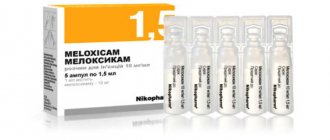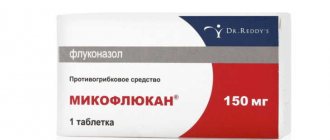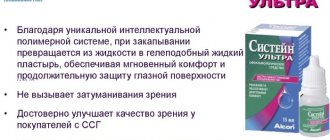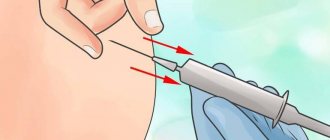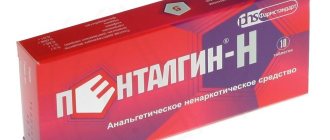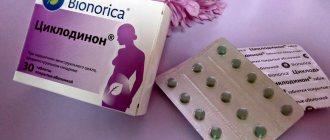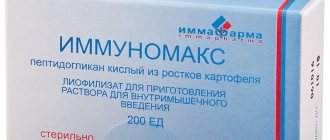Mydocalm injections are an injection solution prescribed to patients with increased muscle tone, which is caused by neurological diseases. The action of the drug is aimed at relaxing muscles, relieving hypertonicity and spasticity and providing an analgesic effect.
At the same time, the drug does not affect consciousness and the state of the central nervous system as a whole. Mydocalm in ampoules is a centrally acting muscle relaxant, belongs to the aminoketone group.
One Mydocalm ampoule contains a dose of 1 ml, the main chemical composition of the solution:
- 100 mg - tolperisone hydrochloride;
- 2.5 mg – lidocaine.
Excipients:
- preservative and antiseptic – methyl parahydroxybenzoate;
- diethylene glycol monoethyl ether, obtained using ethylene oxide with ethanol;
- distilled water for injection.
Composition and release form
The product, which has the trade name Mydocalm-Richter, contains active substances - tolperisone and lidocaine hydrochlorides . In addition to them, additional ingredients are used:
- diethylene glycol monoethyl ether;
- injection water;
- methyl parahydroxybenzoate.
The medication is packaged in ampoules with a capacity of 1 ml. Available in the form of liquid for intramuscular and intravenous administration. At the pharmacy you can purchase the product in a cardboard box with a plastic container inside.
One package contains 5 ampoules and instructions for using the substance. The solution may have a distinct, specific odor. The liquid itself is usually transparent, but in some cases it may have a greenish tint.
Pharmacodynamics and pharmacokinetics
The medication belongs to the muscle relaxant group of drugs with a central mechanism of action. They are intended to provide local anesthetic, muscle relaxant and membrane stabilizing assistance.
The effect of the active component on the body has not been fully studied. It has a direct effect on the first motor neurons located in the spinal canal. The membrane-stabilizing effect blocks the progression of excitation in the primary afferent fibers.
Because of this, monosynaptic and polysynaptic reflexes of the spinal cord are blocked. The mechanism of secondary action blocks the penetration of calcium ions into the presynaptic endings and blocks the flow of impulses from the spinal cord.
A decrease in reflex readiness in the reticulospinal tracts of the brain is ensured by tolperisone. It has a beneficial effect on increasing peripheral blood circulation. The substance does not have a negative effect on the central nervous system.
The active substance helps relieve muscle hypertonicity, lower the threshold of pain sensitivity, and muscle rigidity. The drug promotes ease of movement and increases the motor amplitude of the limbs. The product has the effect of dilating blood vessels.
Lidocaine has a local anesthetic effect. When introduced into the body, it reduces the activity of sodium channels. In this case, the passage of impulses along the nerve fibers becomes impossible. Lidocaine has no systemic effect on the body.
Tolperisone is actively converted in the liver and kidneys. In the form of metabolites, the drug leaves the body through the kidneys. After administration of the drug through the veins, its half-life lasts about 1.5 hours.
Lidocaine is completely absorbed. The rate of absorption of the element depends on the area of administration and dose of the drug. In the blood plasma, the maximum concentration in the case of intramuscular administration of the substance reaches half an hour later. Lidocaine passes freely through the placenta and blood-brain barrier. It can be transmitted through mother's milk during lactation. It is excreted from the body mainly with bile and urine (about 10%).
Side effects
Most often, the patient’s body reacts to Mydocalm injections with hyperemia of the skin at the injection site.
Infrequently, individual reactions such as:
- anorexia;
- sleep disorders;
- headaches and dizziness , excessive drowsiness ;
- arterial hypotension;
- dyspeptic and dyspeptic disorders;
- muscle weakness and soreness, pain in the limbs;
- symptoms of asthenic syndrome , a feeling of general discomfort, increased fatigue.
Rarely occurring adverse reactions that occur less than once in a thousand, but more often than once in ten thousand cases, include:
- hypersensitivity reactions;
- depression , decreased physical activity;
- attention disorders, convulsions , excessive drowsiness, hypoesthesia , tremor , etc.;
- visual disturbances;
- noise in ears ; loss of balance, accompanied by a feeling of one’s own body rotating around objects or, conversely, objects rotating around the body;
- rapid heartbeat, angina pectoris , decreased blood pressure ;
- hyperemia ;
- nosebleeds, difficulty breathing, shortness of breath ;
- abdominal pain, constipation , flatulence , vomiting;
- liver damage (usually mild);
- skin reactions (itching, burning, increased sweating, rash, etc.);
- urinary incontinence , increased protein concentration in the urine (above the physiological norm);
- increased irritability, severe thirst, feeling of intoxication;
- changes in laboratory values (changes in the concentration of bilirubin in the blood , impaired activity of liver enzymes , etc.).
In isolated cases it is possible:
- anaphylactic shock;
- swollen lymph nodes ;
- unnaturally strong, unquenchable thirst;
- confusion;
- decreased heart rate (to a rate of less than 55 beats per minute);
- osteopenia;
- of creatinine in the blood .
Indications
Patients should be prescribed Mydocalm-Richter for certain diseases. You can find out what the drug helps with from the annotation. Most of the indications for prescription are all kinds of pain in the spine. They appear as a result of strong muscle contraction resulting from pinching of nerve roots. Pinched nerves are usually accompanied by pain of varying intensity.
The active ingredients of the drug have a relaxing effect. To reduce pain and restore human mobility, the drug is prescribed for diseases:
- radiculitis;
- osteochondrosis;
- spondylolisthesis;
- cervicalgia;
- lumbodynia;
- sciatica.
If arthrosis develops in the area of the hip or knee joints , the instructions for using Mydocalm-Richter recommend giving injections. If left untreated, spastic muscle contractions can lead to severe pain.
For disorders of the nervous system such as myelopathy, hemorrhagic stroke, encephalitis, myelitis, multiple sclerosis, the medicine can reduce the severity of muscle hypertonicity.
The use of the drug in several courses is indicated after operations performed on joints, ligaments or muscles. It is included in complex compositions for various disorders of the vascular system . In case of capillary dysfunction with insufficient blood circulation and gait disturbances of various etiologies, this medication should be used for treatment.
conclusions
Reviews from patients taking the drug Mydocalm are mostly positive. But it should be prescribed by a neurologist, taking into account the diagnosis, medical history and age of the patient.
Drug passport
Reviews from patients taking the drug Mydocalm are mostly positive. But it should be prescribed by a neurologist, taking into account the diagnosis, medical history and age of the patient. If you have taken a muscle relaxant, please leave a review of the drug. This will help neurologists and their patients form an opinion about Mydocalm.
Instructions for use, dosage
In each specific case, the dosage and treatment period are selected individually by the doctor. Tablets are usually prescribed to patients under 14 years of age. Intramuscular and intravenous injections are indicated for use in adults. According to the instructions for use of Mydocalm-Richter injections, the drug is prescribed:
- For preschool children (from 3 to 6 years old), a daily dosage of 5 mg per 1 kg of child weight is prescribed.
- Children of senior school age (from 7 to 14 years old) are prescribed 2-4 mg per 1 kg of body weight three times a day.
- For adolescents over 14 years of age and adults, the dosage is increased to 50 mg per 1 kg of weight, 3 times a day. Individually, the portion can be increased to 150 mg per use.
It is necessary to take the tablet form of the drug after the main meal. Any liquid except dairy products is allowed. The injection form of the drug has a different use pattern:
- The guide for prescribing Mydocalm injections recommends injecting 1 ml into the muscles per dose 2 times a day. The duration of the injection should not exceed 5 minutes.
- When administered intravenously, 1 ml of the substance is required per injection. In this case, you should use the product with a dropper extremely slowly. This need is caused by the likelihood of a sharp drop in blood pressure.
- The duration of taking the tablets depends on the severity of the disease. To eliminate pain and relieve muscle tension, a month-long treatment period is required. Multiple courses of therapy may be required for patients with poor circulation or as a recovery after surgery. Long-term therapy is often practiced with injections.
One course of injection therapy takes no more than 10 days. If necessary, treatment is extended with new courses after a short break.
Undesirable effects
Reviews of the use of Mydocalm indicate that this medicine often causes side effects. The most common undesirable symptoms from the nervous system, muscles and gastrointestinal tract are:
- sleep disorders (insomnia or drowsiness);
- drop in blood pressure;
- headache;
- dizziness;
- leg pain;
- muscle weakness;
- feeling tired;
- dyspeptic symptoms;
- excessive weight loss.
More rare are allergic reactions (including anaphylaxis), dermatitis, asthenic depression, enuresis, tachycardia, and tremor. Some patients experience a feeling of intoxication and fever after an injection or taking pills. The medicine may affect the results of biochemical and general blood tests.
It is extremely rare to experience a sharp drop in hemoglobin levels, enlarged lymph nodes, a decrease in bone mineral density, and confusion.
To avoid unwanted effects, doctors try to prescribe Mydocalm in courses.
There were no cases of drug overdose. This medicine is not considered toxic. However, you should not exceed the recommended dose of the medication, as this may cause side effects. If a person has taken an excessive amount of tablets, it is necessary to rinse the stomach and take activated charcoal. Then you need to seek medical help. Treatment of overdose is symptomatic.
Contraindications and side effects
Adverse effects can occur in a large number of patients in the form of digestive disorders and skin itching. Some side effects are noticed infrequently. Such complications include the following:
- Complete refusal to eat and loss of appetite.
- Headache, fatigue, sleep disorders.
- Decreased pressure.
- Dry mucous membranes.
- Muscle weakness, soreness in the body.
- Diarrhea.
- Development of depressed mood.
- The occurrence of various allergic reactions, reaching anaphylactic shock.
- Changes in sensitivity to irritating factors.
- Memory and attention disorders.
- Increased breathing rate, change in heart rate.
- Discomfort in the abdominal area.
- Skin allergic phenomena.
- Increased number of urinations.
- Pain in the periarticular area.
- Decrease in the number of platelets and leukocytes in test parameters.
In very rare cases, a decrease in hemoglobin and red blood cell levels is likely. Peripheral lymph nodes can increase in size, and contractions of the heart muscle slow down. Bones become less strong during the treatment period, and their fragility increases. Blood tests show a marked increase in creatinine levels.
Not all patients are eligible for this dosage form. Contraindications include:
- Predisposition to allergic reactions to the components of the product.
- Severe form of myasthenia.
- Patients' age is up to 18 years.
- The period of bearing a child.
- Breastfeeding a baby (due to lack of data).
Patients with hepatic or renal insufficiency require dose adjustment. In this case, the drug should be prescribed with extreme caution.
Analysis of positive reviews
Reviews from people taking Mydocalm tablets are positive in 73% of cases. Patients note the ease of administration, quick effect, and absence of side effects. The indication for taking the drug is only to relieve muscle spasticity after a stroke, but it was prescribed to patients with intervertebral hernias, osteochondrosis of various parts of the spine, and myositis.
Reviews of Mydocalm for cervical osteochondrosis are positive in 100% of cases. Some patients note that improvement occurred within the first day of treatment. But in severe cases of the disease, accompanied by numbness of the hands and paresthesia, long-term use of a muscle relaxant was required. The duration of the course in this case is up to a month, and to alleviate the condition it took at least 2 weeks.
Overdose
The drug has a wide therapeutic index. Preclinical studies have shown that the introduction of the substance into the human body in dosages exceeding established standards can cause difficulty breathing, tonic and clonic seizures, and ataxia in the absence of muscle weakness.
Tolperisone does not have a specific antidote. If you consume an increased amount of medication, you should immediately perform a gastric lavage. After this, it is necessary to prescribe supportive and symptomatic therapy.
Compatibility with other drugs
Complete data on interactions with other medications have not yet been obtained. Based on these indications, it is prohibited to dilute the substance with other dosage forms in the same syringe. Mydocalm must be administered separately.
The drug does not have a sedative effect on the body. The medicine can be prescribed in combination with sedatives, sleeping pills, and medications that contain alcohol.
When used simultaneously with centrally acting muscle relaxants, it is necessary to reduce the daily dosage of tolperisone. The amount of non-steroidal anti-inflammatory drugs should also be reduced.
Tolperisone is capable of increasing the effect on the human body of muscle relaxants, psychotropic substances, clonidine, and drugs for general anesthesia.
The instructions for use contain special instructions that must be followed during the treatment period. During treatment, it is better to free patients from work that requires constant concentration and speed of thought processes. Driving vehicles during this period is not recommended.
Mydocalm - patient reviews
“I took Mydocalm 2 times. The first time for back pain, the second time for tension headaches. The impression is twofold. With osteochondrosis, I forgot about the problem on the 3rd day. The drug did not help with headaches.” Anatoly 34 years old.
“My grandmother suffers from arthrosis and osteochondrosis. Mydocalm was prescribed as part of the treatment. There is an improvement. She survived the summer without exacerbations and did not use a stick while moving. In the fall, the joints became inflamed, but after taking Mydocalm, the condition quickly improved.” Tatyana is 40 years old.
Analogues and cost
Mydocalm injections can be replaced with products that are identical in their effect on the body. Analogs should have a muscle relaxant effect. The main components in this case must be different. It is better if the substitute contains: mefedol, baclofen, or intrathecal lioresal. Among the inexpensive products are: Miolgin, Baclofen, Tizanidine, Arthrozan, Amelotex, Movalis, Mesipol and others.
The average cost in Russia of Mydocalm-Richter 1 ml No. 5 for 2021 is 600 rubles. Depending on the region where the patient lives, it may cost a little more or less. The price for 5 ampoules of Mydocalm injections can be reduced by ordering the product on the website of any pharmacy chain. Websites often provide additional discounts for customers. How many packs you need to purchase for a course of treatment should be found out from a specialist.
Pros and cons of a muscle relaxant
According to reviews from patients taking Mydocalm tablets and people caring for patients with spinal diseases, the following advantages of the muscle relaxant are highlighted:
- efficiency;
- rapid analgesic effect;
- minimum contraindications and side effects;
- cost in comparison with muscle relaxant analogues.
The disadvantage of the product is its effect on smooth muscles. This causes problems with defecation, urination, and flatulence.
Use during pregnancy and lactation
No studies have been conducted on pregnant or lactating women. Experiments on animals did not show any abnormalities in fetal development when the drug was prescribed. Injections are especially contraindicated in the first trimester, during pregnancy.
In subsequent trimesters, it is permissible to use the medication at the discretion of the treating specialist. The doctor is obliged to provide all tangible benefits for the mother, which must outweigh the risk of possible complications for the unborn child.
When breastfeeding, the use of the product is unacceptable due to the lack of complete data. During the treatment period, it is necessary to stop feeding milk and switch to formula. If desired, a woman can save lactation for further breastfeeding.
The scope of application of Mydocalm is constantly expanding. Neurologists actively use the drug in their practice, curing people with severe diagnoses. The active ingredients in various products complement each other's action.
Negative reviews
There are few negative reviews from patients who took Mydocalm. But they are not associated with the lack of therapeutic effect of the drug.
Patients note the following:
- effectiveness only during treatment; after discontinuation, cramps and numbness return;
- bitter taste - when prescribing the drug to children, the tablets have to be divided. The taste cannot be masked by adding juice, milk, or jam;
- 1% of patients - the drug was completely ineffective;
- relaxation of smooth muscles - this was expressed in impaired defecation, pain in the intestines, frequent urination; in women there was pain in the pelvis;
- 1% of patients developed allergic reactions - accompanied by itching, fever, and rash. In severe cases, bronchospasm, asthma attacks, and Quincke's edema were present.
